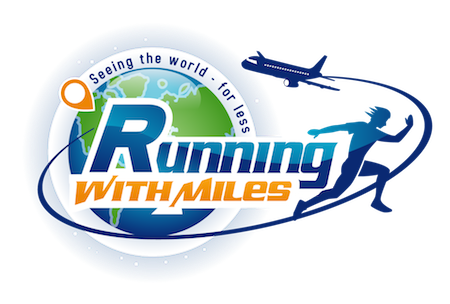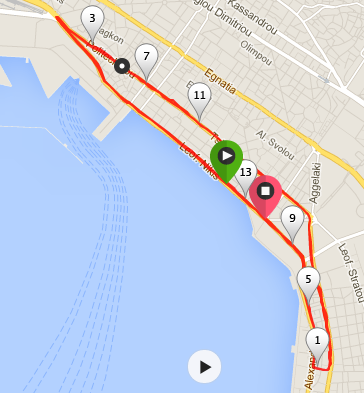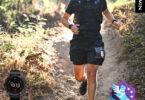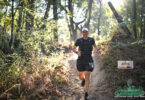Half Marathons have grown to be an incredibly popular racing distance (13.1 miles). They used to be an add-on to established marathons but have become a genuine race distance and interest in their own right. In fact, most of the marathons that offer a half marathon see the entrant numbers for the half at well over double that of the marathon entrants.
One of the things I love about half marathons is how perfect the distance is. It is possible to really run a nice, fast race without feeling totally trashed the next day (unlike how I would feel following an all-out effort in a marathon). I have not run as many half marathons as I would like simply because I have a hard time running a half when a full is run at the same event. 🙂 So, when a stand alone half marathon takes place, I really jump on those!
My Favorite Half Marathon Course
Last week, I ran a half marathon that is one of the few that I have run multiple times – it was the Thessaloniki Nighttime Half Marathon. It has really become a favorite for me as a course and as a race (look for a review of this great race coming this week). Not only am I quite familiar with the roads that it is run on, but a nighttime race is really perfect for a number of reasons.
Two of my top three half marathon times have taken place at this race, so one would think that is why this is my favorite half marathon course. 🙂 But, actually, it is the other way around – I have run well at this race because it is my favorite half marathon course! Here are some of the things that have made this my favorite half marathon course.
Night
Running a race at night really is quite an advantage. If you plan your movement properly throughout the day, running a race at night gives you ample time to become loose while still having received a good night’s sleep. I don’t know about you, but when I am running a race in the morning, I do not sleep well the night before the race. Because of that, I rarely feel at the top when I begin a race in the morning. That normally means that my first couple of miles are going to be a little on the rough side (even after some warmup runs).
Another good thing about a nighttime race is that you can eat the appropriate meals before the race, when it really matters the most. To get the food necessary for a longer race in the morning, you technically should be up and eating around 4AM (for a race that starts around 7AM). Beginning a race at night gives you the opportunity to eat food at normal times.
And yet another high point for me about a nighttime run is that it is really a cool time of the day. This race starts at 6:45PM, so the sun is just about to set when the race starts. It gives some great views on the start but then you get to run the majority of the race in the cooler part of the day.
Laps
A race course that has multiple laps can be very helpful, depending on the distance of each lap. I have run 12 hour races that were run on a 1/2 mile loop and that can be a little difficult. 🙂 But, this race had laps around 4.3 miles long (with the finish line moved the appropriate distance from the starting line to make the total distance of 13.1 miles). That means you have 3 laps during the race. That is really a great distance as it allows the race organizers to setup some very good aid stations that you will pass multiple times. In this case, we had three aid stations (roughly every 1.3 miles apart). They were well-stocked and you knew exactly where they were on each lap. That made for less congestion at the aid stations.
Laps also give you the opportunity to have an idea of how to run the course the most efficiently. The first lap shows you what to expect for the race and you can formulate a good plan for the last two laps based on your introduction to the first lap. You can see the corners, the tight places of the course, street problems (potholes, for example) – just a great overview within the first few miles.
Finally, nothing helps you with your pacing late in the race than being able to lap other runners! It is an incredible boost in those late, tired miles to be able to lap other runners. If your pace is going to be faster than 8 minutes per mile, you will certainly pass other runners on this final loop. This not only helps you with the increased crowd of runners in the last leg, but it also helps to push harder the more you see that you are passing others. Of course, you are not racing them, but it is simply something to help, mentally, to pass others.
Not only are you lapping some runners, but you are also pulling up on runners that went out too fast at the beginning (but this is true of any race).
Somewhat Flat
I know some people greatly prefer a flat course, but I do like course that has some variety to it. It gives me a chance to work out different muscle groups as well as having variety in the pace during the race. In this particular race, I knew I was going to have one specific part of the course that there was a gradual grade up but I got to enjoy it descending a little steeper on the flip side (nothing too extreme).
While this elevation profile might look like it is really bumpy, it was actually not that bad at all. As you will see as well, my pace stayed fairly constant throughout the course.
Summary
This course has quickly become my favorite half marathon course. These are the highlight reasons why that is so. Do you have a favorite type of race course? Which race is it and what makes it your favorite?









